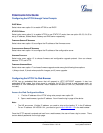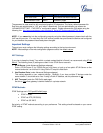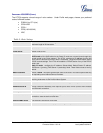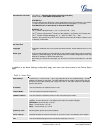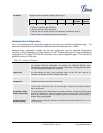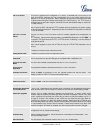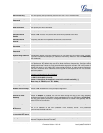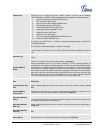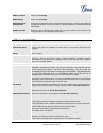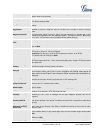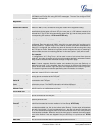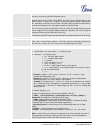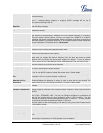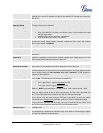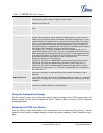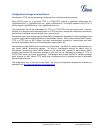
Grandstream Networks, Inc. HT-70X User Manual Page 24 of 35
Firmware Version 1.0.0.18 Last Updated: 03/2012
RADIUS Timeout
Default is 2. HT704 Only
RADIUS Retry
Default is 3. HT704 Only
Download Device
Configuration
Allows user to download and save a text file containing all the P values of each setting as
configured at that point on the unit. (Note: For Security Reasons, all Passwords won’t be
Downloaded)
Upload Firmware
Allows the user to upgrade the firmware with a single firmware file by browsing and
loading the file from your computer (local directory).
Table 11: Account Settings
Profile Active
When set to Yes the FXS port or Profile (for HT704) is activated.
Primary SIP Server
SIP Server’s IP address or Domain name provided by VoIP service provider.
Failover SIP Server
Failover SIP Server’s IP address or Domain name in case primary server does not
respond.
Prefer Primary SIP
Server
Default is No. If set to yes, it will register to Primary Server if registration with Failover
server expires
Outbound Proxy
IP address or Domain name of Outbound Proxy, or Media Gateway, or Session Border
Controller. Used by HT70X for firewall or NAT penetration in different network
environments. If symmetric NAT is detected, STUN will not work and ONLY outbound
proxy can correct the problem.
SIP transport
User can select UDP or TCP or TLS. Default is UDP.
NAT Traversal (STUN)
This parameter defines whether or not the HT70X NAT traversal mechanism is
activated. If activated (by choosing “Yes”) and a STUN server is also specified, then the
HT70X performs according to the STUN client specification. Using this mode, the
embedded STUN client will detect if and what type of firewall/NAT. If the detected NAT
is a Full Cone, Restricted Cone, or a Port-Restricted Cone, the HT70X will use its
mapped public IP address and port in all of its SIP and SDP messages.
If the NAT Traversal field is set to “Yes” with no specified STUN server, the HT70X will
periodically (every 20 seconds or so) send a blank UDP packet (with no payload data)
to the SIP server to keep the “hole” on the NAT open.
SIP User ID
User account information, provided by VoIP service provider (ITSP). Usually in the form
of digit similar to phone number or actually a phone number. HT701 and HT702 only
Authenticate ID
SIP service subscriber’s Authenticate ID used for authentication. Can be identical to or
different from SIP User ID. HT701 and HT702 only
Authenticate Password
SIP service subscriber’s account password. HT701 and HT702 only
Name
SIP service subscriber’s name for Caller ID display. HT701 and HT702 only
DNS Mode
One from the 3 modes are available for “DNS Mode” configuration:
-A Record (for resolving IP Address of target according to domain name)
-SRV (DNS SRV resource records indicates how to find services for various protocols)
-NAPTR/SRV (Naming Authority Pointer according to RFC 2915)
One mode can be chosen for the client to look up server.
The default value is “A Record”
Tel URI
The default setting is “Disabled”. If the phone has an assigned PSTN
Number, this field should be set to “User=Phone” then a
“User=Phone” parameter will be attached to the “From header” in the SIP



